Commodity flow or domestic trade refers to the flow of commodities through the water, air and rail transport systems in the country. Data on the inflow and outflow of commodities in the different regions of the country are used to construct interregional and inter-industry relation tables. These serve as bases in the formulation and implementation of various regional development programs like countryside development and port planning.
Quantity of domestic trade declines, value increases
The total quantity of domestic trade transactions in the third quarter of 2011 decreased by 4.5 percent, resulting to 4.30 million tons from 4.50 million tons reported during the same period of last year. The commodities were traded mostly through water comprising 99.8 percent, the same percentage recorded in the third quarter of 2010.
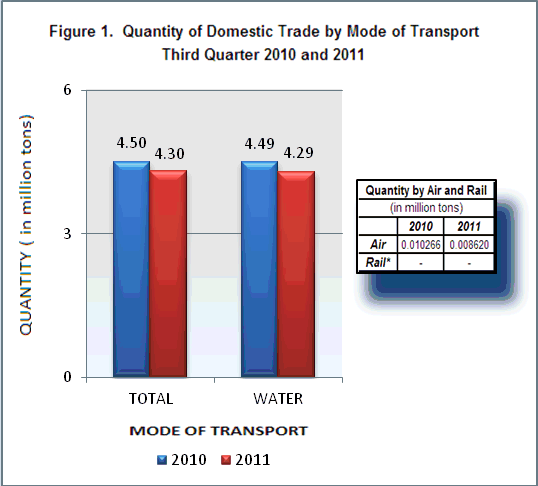
On the other hand, the total value of commodities flowed within the country increased by 15.0 percent from PhP94.22 billion in the third quarter of 2010 to PhP108.38 billion in the same period of 2011. Trade transaction through water was the major mode of transport comprising 99.3 percent, the same percentage recorded in the third quarter of 2010.
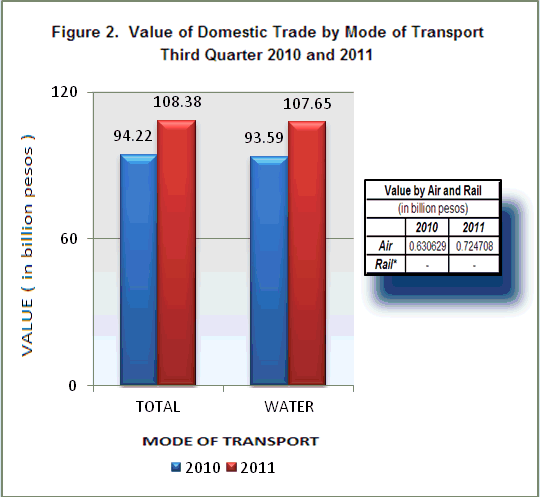
Food and live animals dominates total domestic trade value
Food and live animals contributed the largest share among the commodities transacted throughout the country in the third quarter of 2011, amounting to PhP29.86 billion (27.5%). This was followed by machinery and transport equipment with PhP23.23 billion (21.4%) and manufactured goods classified chiefly by materials with PhP15.10 billion (13.9%). Animal and vegetable oils, fats and waxes shared the least value of PhP1.28 billion (1.2%). (See Table 1)
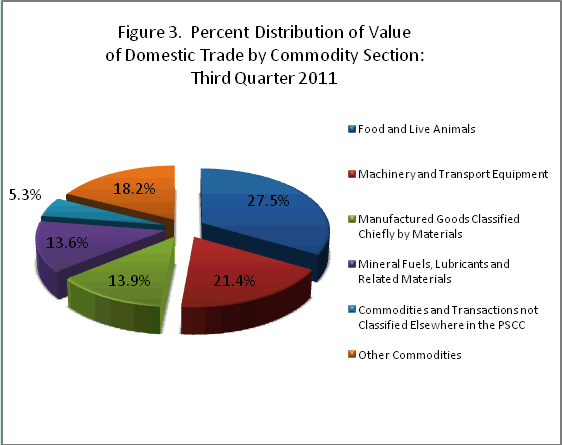
Similarly, food and live animals dominated the domestic trade in the third quarter of 2010, with a share of 27.4% (PhP25.84 billion) of the total value. Machinery and transport equipment was second with a 23.5 percent share (PhP22.17 billion). Mineral fuels, lubricants and related materials followed with a share of 16.9 percent (PhP15.94 billion). Contributing the least value of PhP1.84 billion was animal and vegetable oils, fats and waxes. (See Table 1)
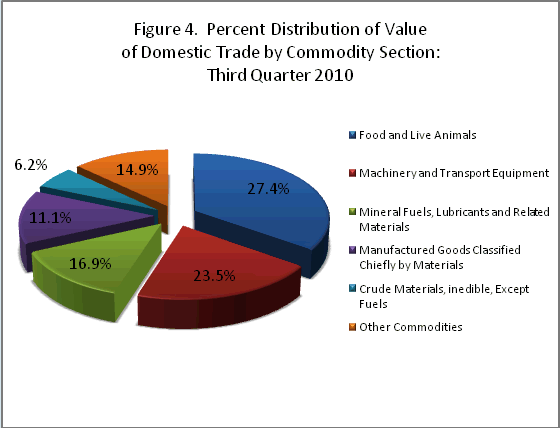
National Capital Region (NCR) accounts for the largest value of domestic trade
In the third quarter of 2011, most of the traded commodities originated from National Capital Region with value of domestic trade amounting to PhP30.13 billion (27.8%). Central Visayas was the second with PhP21.61 billion (19.9%). Northern Mindanao was next with PhP13.05 billion (12.0%), followed by Central Luzon with PhP11.97 billion (11.0%). Cagayan Valley�s domestic trade contributed the least share among the regions with only PhP130 thousand.
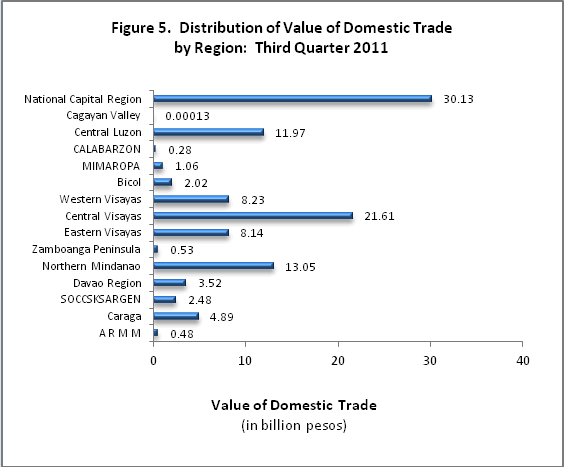
During the same period last year, Northern Mindanao had the highest domestic trade share at PhP15.78 billion (16.8%). Eastern Visayas was the second with PhP13.62 billion (14.5%). Central Luzon was next with PhP12.54 billion (13.3%), followed by NCR with PhP12.42 billion (13.2%). Cagayan Valley�s domestic trade contributed the least share among the regions with only PhP73 thousand. (See Table 2)
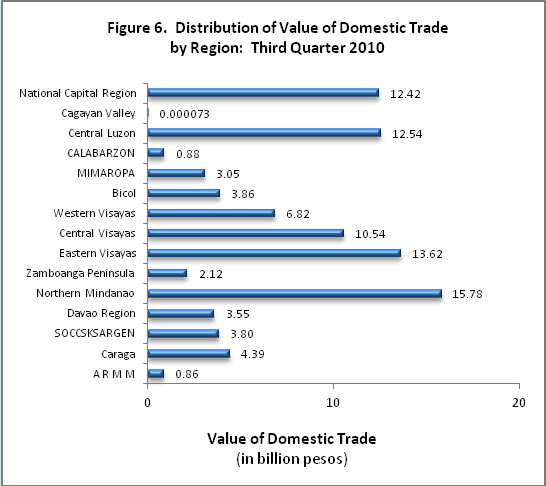
Central Luzon leads the highest favorable trade balance
In the third quarter of 2011, Central Luzon posted the most favorable trade balance at PhP11.58 billion. The only other region which surpassed the billion positive trade balance was NCR with PhP9.56 billion. On the other hand, Western Visayas suffered an unfavorable trade balance of negative PhP6.90. Other regions with more than a billion negative trade balances were Caraga (PhP5.09 billion), Zamboanga Peninsula (PhP4.31 billion), CALABARZON (PhP2.09 billion), Davao Region (PhP1.52 billion), and Eastern Visayas (PhP1.39). (See Table 4)
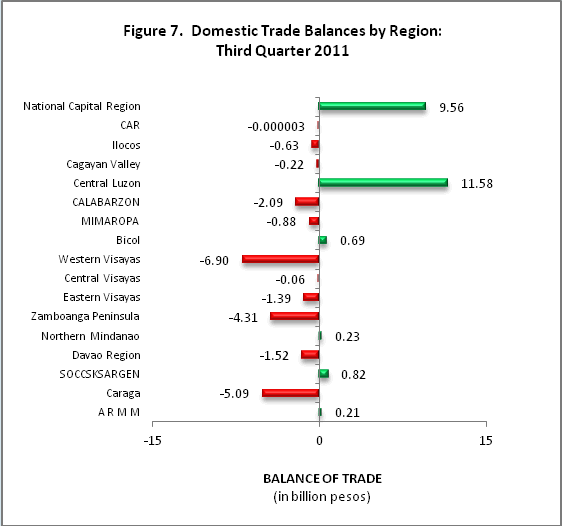
Likewise, Central Luzon posted the most favorable balance of trade at PhP12.05 billion during the third quarter of 2010. Other regions which surpassed the billion positive trade balance were Eastern Visayas (PhP8.21 billion), Northern Mindanao (PhP7.53) and SOCCSKSARGEN (PhP3.11) On the other hand, NCR suffered an unfavorable trade balance of negative PhP9.12 billion.
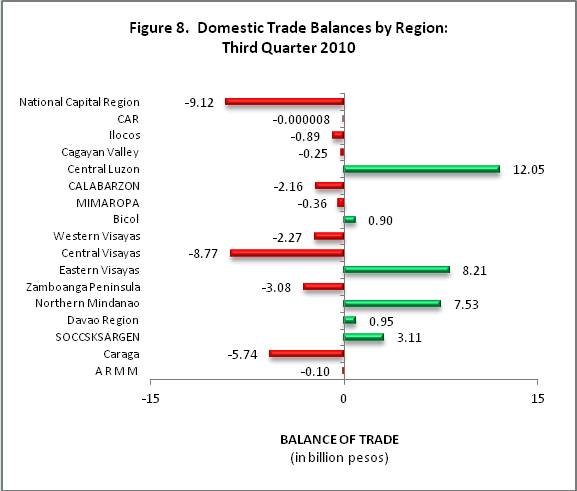
Notes:
- DOMSTAT reports from the following provinces/cities were not yet received as of December 09, 2011, and were not included in this special release:
- Romblon - Coastwise (July to September 2011)
- Masbate - Coastwise (September 2011)
- Negros Occidental - Coastwise (August & September 2011); Air (September 2011)
- Negros Oriental - Coastwise (August & September 2011)
- Western Samar - Coastwise (September 2011); Air (September 2011)
- Agusan Del Norte - Coastwise (August & September 2011) ; Air (August & September 2011)
- Zamboanga City - Coastwise (August & September 2011); Air (September 2011)
- Basilan - Coastwise (July to September 2011)
- Sulu - Coastwise (July to September 2011)
- Philippine National Railways (PNR) has not resumed its operation.
Source: National Statistics Office
Manila, Philippines
